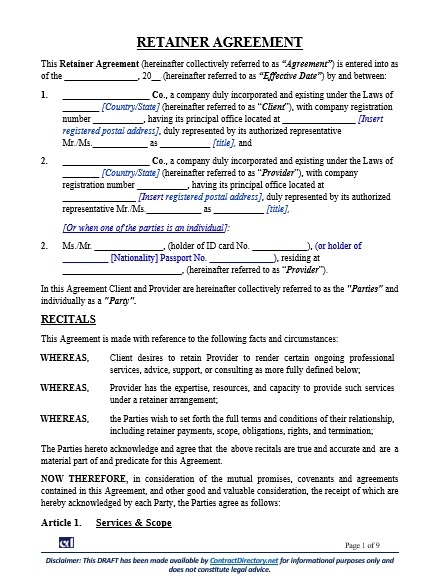A Retainer Agreement is a continuous service contract between a client and a provider. It guarantees access, commitment, and availability. The client pays a recurring fee to keep the provider on call and ready to act. This arrangement works best in law, consulting, marketing, IT, and design—where expertise must be readily available at all times.
A strong Retainer Agreement, such as the one drafted by ContractDirectory.net, clearly defines the scope of services, retainer fees, and billing terms. It also sets standards for confidentiality, intellectual property, and renewal. Unlike short-term contracts, this model focuses on long-term cooperation and consistent professional presence.
How the Retainer Agreement Works
In this structure, the provider earns a fixed recurring fee, often monthly or quarterly. That payment ensures dedicated time, priority, and rapid response. Both parties agree on details such as independence, non-exclusivity, and conflict disclosure. Clear dispute-resolution clauses—like mediation and arbitration—maintain trust and prevent escalation. Through confidentiality and ownership terms, the agreement safeguards both business interests.
Difference Between Retainer Agreement and Service Agreement
A Service Agreement is project-based. It defines deliverables and deadlines and ends once the task is done. A Retainer Agreement, instead, focuses on the relationship. It pays for availability and readiness, not a single outcome. While a Service Agreement answers “what will be done?”, a Retainer Agreement answers “who will be there when needed?”. That makes it ideal for continuous advisory or technical support.

Why Businesses Use Retainers
Companies rely on retainer models to secure steady expertise and control costs. Clients gain fast access to trusted professionals. Providers enjoy predictable income and stable partnerships. This structure turns cooperation into a consistent and measurable alliance, reducing friction and negotiation time. Vider receives a fixed recurring fee (monthly or quarterly) in exchange for maintaining dedicated time and expertise for the client. That payment ensures priority access, continuity, and fast response. The agreement often includes clauses on independent contractor status, non-exclusivity, conflict disclosure, and dispute resolution. By including arbitration, confidentiality, and intellectual property provisions it provides a full legal framework for enduring partnerships built on reliability.
Difference Between Retainer Agreement and Service Agreement
A Service Agreement governs defined deliverables and project outcomes—it is task-based and ends upon completion. A Retainer Agreement, however, governs the relationship itself. It compensates the provider for availability rather than a single result. While a Service Agreement answers “what will be done and by when?” a Retainer Agreement answers “who will always be there when needed?” This distinction makes retainers ideal for professionals whose value lies in sustained guidance, rapid response, and cumulative expertise.
Why Businesses Use Retainers
Companies choose retainer models to secure reliable professional support, stabilize monthly costs, and foster stronger working relationships. For providers, it ensures predictable income and client retention; for clients, it guarantees continuous access to trusted expertise without constant renegotiation.
References:
- American Bar Association – Retainer and Fee Agreements Guidelines:
- Law Society of Ontario – Best Practices for Retainer Contracts:
- ACCA Global – Client Retainer Arrangements Explained:
- Harvard Law School Program on Negotiation – Structuring Long-Term Service Agreements:
.
Related Topics:
#RetainerAgreement #OnCallContract #ServiceContract #BusinessLaw #LegalTemplates #ContractDirectoryNet
has been added to your cart!
have been added to your cart!



